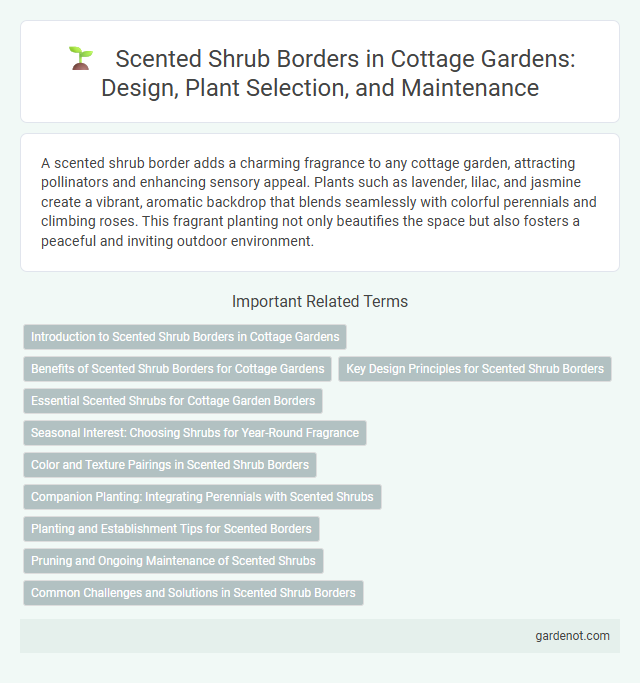A scented shrub border adds a charming fragrance to any cottage garden, attracting pollinators and enhancing sensory appeal. Plants such as lavender, lilac, and jasmine create a vibrant, aromatic backdrop that blends seamlessly with colorful perennials and climbing roses. This fragrant planting not only beautifies the space but also fosters a peaceful and inviting outdoor environment.
Introduction to Scented Shrub Borders in Cottage Gardens
Scented shrub borders in cottage gardens combine fragrant plants like lilacs, viburnum, and mock orange to create a sensory-rich environment. These borders provide year-round aroma, blending sweet, spicy, and citrusy scents that attract pollinators and enhance garden ambiance. Incorporating scented shrubs also adds structural interest and lush greenery to traditional cottage garden designs.
Benefits of Scented Shrub Borders for Cottage Gardens
Scented shrub borders enhance cottage gardens by providing year-round fragrant blooms that attract pollinators like bees and butterflies, promoting biodiversity. These borders create natural privacy screens while adding texture and color variation, enriching the garden's visual appeal. The aromatic foliage also offers sensory enjoyment and can reduce the need for chemical pesticides due to their natural insect-repellent properties.
Key Design Principles for Scented Shrub Borders
Scented shrub borders in cottage gardens thrive by combining aromatic varieties such as lavender, rosemary, and viburnum with layered planting to maximize fragrance release throughout the day. Strategic placement along pathways and seating areas enhances sensory experiences while maintaining a balance between sun and shade requirements for each shrub type. Incorporating staggered bloom times and diverse foliage textures ensures continuous seasonal interest and an immersive, fragrant environment.
Essential Scented Shrubs for Cottage Garden Borders
Essential scented shrubs for cottage garden borders include lavender (Lavandula angustifolia), which offers a calming fragrance and attracts pollinators, and lilac (Syringa vulgaris), known for its strong, sweet aroma and spring blooms. Other integral shrubs are viburnum (Viburnum carlesii) with its spicy scent and extended flowering period, and rosemary (Rosmarinus officinalis), providing a woody fragrance and evergreen foliage. Incorporating these aromatic shrubs enhances sensory appeal while contributing texture and seasonal interest in cottage garden borders.
Seasonal Interest: Choosing Shrubs for Year-Round Fragrance
Selecting scented shrubs such as lavender, jasmine, and rose occupies a central role in creating a cottage garden's scented shrub border, ensuring continuous seasonal interest through a spectrum of floral fragrances from spring to autumn. Incorporating evergreen varieties like boxwood or viburnum maintains aromatic appeal throughout winter months, providing a consistent olfactory experience and structural garden interest. Thoughtful layering and timing of bloom periods enhance the border's year-round fragrance profile, stimulating sensory engagement across all seasons.
Color and Texture Pairings in Scented Shrub Borders
Scented shrub borders in cottage gardens showcase vibrant color and texture pairings, combining fragrant blooms such as lilacs, gardenias, and viburnums for a sensory-rich experience. The interplay of glossy evergreen leaves with soft, delicate petals creates visual depth and tactile contrast, enhancing the border's appeal. Incorporating shrubs with varying bloom colors--from creamy whites to deep purples--amplifies seasonal interest and fragrant ambiance.
Companion Planting: Integrating Perennials with Scented Shrubs
Scented shrub borders thrive when paired with complementary perennials such as lavender, catmint, and nepeta, which enhance fragrance and attract pollinators. Strategic companion planting ensures continuous bloom cycles, enriching the garden's sensory appeal and supporting beneficial insects. Combining these perennials with scented shrubs like lilac and viburnum creates layered textures and diverse aromatic profiles in cottage gardens.
Planting and Establishment Tips for Scented Borders
Plant fragrant shrubs such as lavender, rosemary, and lilac to create a scented shrub border that thrives in well-drained soil and full sun. Space plants according to mature size, ensuring good air circulation to prevent disease and encourage robust growth. Mulch regularly to retain moisture and suppress weeds, establishing a long-lasting sensory garden feature.
Pruning and Ongoing Maintenance of Scented Shrubs
Pruning scented shrubs in a cottage garden encourages healthy growth and enhances fragrance by removing dead or overcrowded branches during late winter or early spring. Regular maintenance includes watering during dry periods, mulching to retain soil moisture, and monitoring for pests to ensure vibrant blooms. Proper care results in a flourishing scented shrub border that provides continuous aromatic ambiance and visual appeal throughout the growing season.
Common Challenges and Solutions in Scented Shrub Borders
Pest infestations and fungal diseases frequently challenge scented shrub borders in cottage gardens, particularly with species like lilac and mock orange. Proper spacing and pruning enhance air circulation, reducing mildew and blight risks, while organic insecticidal soaps help manage aphid populations without harming beneficial pollinators. Regular soil testing ensures optimal pH and nutrient levels, supporting robust growth and maximizing fragrance intensity.
Scented shrub border Infographic

 gardenot.com
gardenot.com